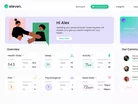New wearable tech helps patients track sickle cell disease

Eleven health has launched a new health tech platform that will enable Sickle Cell Disease (SCD) patients in the UK to track their own health condition, and even be alerted to an oncoming attack of acute pain.
SCD is a condition which is particularly common in people with an African or Caribbean background, and it can cause severe pain and organ failure, often requiring hospital admissions. There are roughly 15,000 people diagnosed with SCD in the UK, but this number is set to rise by 30% by 2050.
The Eleven health platform aims to help the NHS and other organisations to advance understanding and treatment options faster, but also allow SCD sufferers to manage and their own health condition.
SCD is often considered an "invisible disease", and patients are not always given the full understanding of how to manage it in day-to-day life. Much of the burden in monitoring symptoms and disease progression falls upon patients themselves, with mood or pain diaries forming a substantial source of information for clinicians.
35% of adults with SCD suffer from depression – a symptom which Eleven health aims to tackle through collaboration of data, advancements of standards and speed of intervention.
Eleven health users are provided with an FDA-approved smartwatch and digital platform free of charge. This allows them to track:
- Low blood oxygen saturation, common in SCD
- Obstructive sleep apnoea
- Disrupted sleep cycles/patterns linked to increased pain and crisis
- Pain can be tracked and compared day-to-day
- Combining doctor and hospital records in one place
- Psychological wellbeing: emotional changes such as anxiety and low mood are common in people with SCD and tracking episodes can help seek appropriate psychological support
By using this data Eleven aims to provide the knowledge needed to shape the treatment pathways and boost the patients' understanding of their SCD.
Reia DaCosta, a 28-year-old SCD sufferer who lives in London, said: “I’d been having a sickle cell crisis for over two weeks but was managing it at home. As the pain grew more intense I was taking my morphine doses closer each time. I knew I had an infection that was triggering it, but the morphine masked how bad the pain really was.
“I take my heart rate with my watch whenever I have a crisis, this time it gave an abnormal reading. I then checked my oxygen level: it read under 90. I called an ambulance right away. No hesitation. The paramedics were extremely impressed; constant use of morphine can cause respiratory failure and I was at high risk of this. If I didn’t have my watch from Eleven to do my vitals I may have been in a much worse way.”
- How Zipline Uses Drones to Deliver Medicine Across AfricaTechnology & AI
- How is Schneider Electric Making the NHS More Accessible?Hospitals
- How DeepHealth is Using AI to Screen for Breast CancerTechnology & AI
- Martin Carpenter: How Tech is Reshaping Healthcare on JerseyDigital Healthcare



